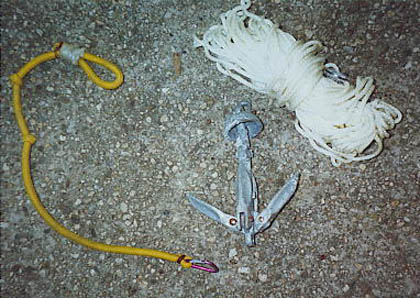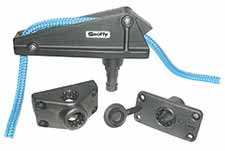 Shock Chord
You may use this more than any other piece of rope, chord, bungee, etc; You can
purchase a shock chord or fashion one yourself. The one shown in the photo is made from a
bungee chord. The elasticity of the chord allows it to absorb some of the energy from a
rolling swell or fast moving current. The most common use for one is to use the chord to
tie your kayak (anchor) to the kelp that grows to the surface. Grab hold of a few strands
of kelp. Wrap the chord around the kelp strands and feed the end of the chord through the
loop in order to create a slip knot around the kelp strands. Pull tight (but not too
tight) and then clip the chord to one of the eyelets on your kayak. Depending upon the
direction of the current, the position of your shock chord will determine the position of your
kayak. Connecting the shock chord to different eyelets around the kayak will alter the
direction your kayak is pointing in. The chord can also be used to tie off to another
kayak. Shock Chord
You may use this more than any other piece of rope, chord, bungee, etc; You can
purchase a shock chord or fashion one yourself. The one shown in the photo is made from a
bungee chord. The elasticity of the chord allows it to absorb some of the energy from a
rolling swell or fast moving current. The most common use for one is to use the chord to
tie your kayak (anchor) to the kelp that grows to the surface. Grab hold of a few strands
of kelp. Wrap the chord around the kelp strands and feed the end of the chord through the
loop in order to create a slip knot around the kelp strands. Pull tight (but not too
tight) and then clip the chord to one of the eyelets on your kayak. Depending upon the
direction of the current, the position of your shock chord will determine the position of your
kayak. Connecting the shock chord to different eyelets around the kayak will alter the
direction your kayak is pointing in. The chord can also be used to tie off to another
kayak.Anchor Just like boaters, kayak anglers may find an anchor useful. Certain circumstances call for "rigging" an anchor to your kayak. The small folding anchors like the one pictured are usually enough to keep your kayak stationary. A bowline of some sort needs to be attached to your kayak so that you may have control over the position of your anchor line (in relation to direction of current). There are several ways you can rig your bowline and anchor to your kayak. Which ever way you go with, you want to make sure you can reposition the anchor rope in order to adjust the position of your kayak as you remain anchored. Using an anchor while kayak fishing is only necessary under certain circumstances. I think I've used it once in 2 years. It's going to depend where you're kayak fishing. A kayak angler fishing one place might have different variables to deal with then someone fishing in a different location.
<back |
 Removable
Anchor Lock & Release System
This device works great! It's especially useful if
you're anchoring at various depths throughout the day. Feed the anchor line through the
front of the Scotty Lock & Release. It's as simple as that. The rope remains
locked until you are ready to hoist your anchor or make an adjustment. The break
automatically releases when you begin to hoist the anchor.
Removable
Anchor Lock & Release System
This device works great! It's especially useful if
you're anchoring at various depths throughout the day. Feed the anchor line through the
front of the Scotty Lock & Release. It's as simple as that. The rope remains
locked until you are ready to hoist your anchor or make an adjustment. The break
automatically releases when you begin to hoist the anchor.